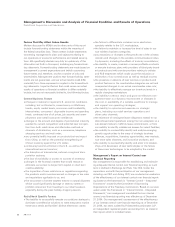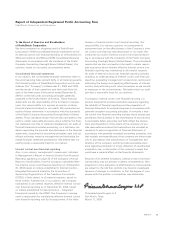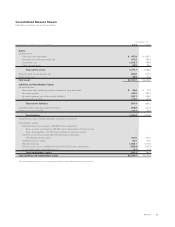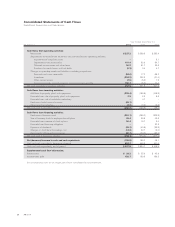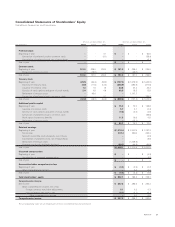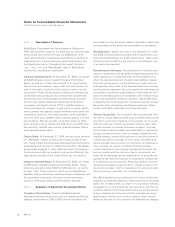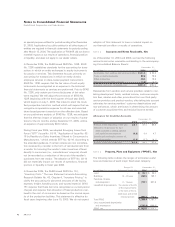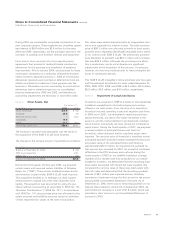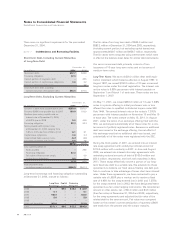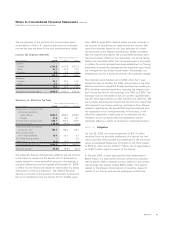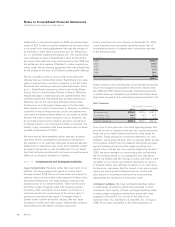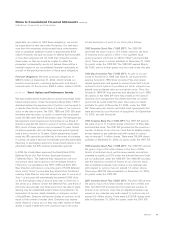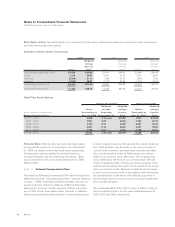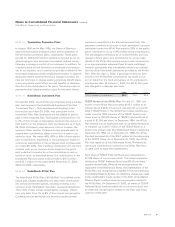Radio Shack 2004 Annual Report Download - page 43
Download and view the complete annual report
Please find page 43 of the 2004 Radio Shack annual report below. You can navigate through the pages in the report by either clicking on the pages listed below, or by using the keyword search tool below to find specific information within the annual report.
ment whenever events or changes in circumstances indicate
that the net book value of the asset may not be recoverable.
Pursuant to the provisions of SFAS No. 142, “Goodwill and
Other Intangible Assets,” goodwill and intangible assets are
not amortized, but are reviewed annually at the end of our
fiscal year for impairment (and in interim periods if certain
events occur indicating that the carrying value of goodwill
and intangible assets may be impaired).
Goodwill and Intangibles: Goodwill represents the excess
of the purchase price over the fair value of net assets
acquired. At December 31, 2004, our net goodwill balance
totaled $26.8 million, comprised primarily of goodwill
resulting from the acquisition of the SAM’S CLUB kiosk
business effective October 1, 2004. Additionally, we had
$25.2 million in intangible assets arising from the SAM’S
CLUB kiosk business acquisition.
Fair Value of Financial Instruments: The fair value of financial
instruments is determined by reference to various market data
and other valuation techniques as appropriate. Unless other-
wise disclosed, the fair values of financial instruments approx-
imate their recorded values, due primarily to the short-term
nature of their maturities or their varying interest rates.
Income Taxes: Income taxes are accounted for using the asset
and liability method. Deferred taxes are recognized for the tax
consequences of “temporary differences” by applying enact-
ed statutory tax rates applicable to future years to differences
between the financial statement carrying amounts and the tax
bases of existing assets and liabilities. The effect on deferred
taxes of a change in tax rates is recognized in income in the
period that includes the enactment date. In addition, we rec-
ognize future tax benefits to the extent that such benefits are
more likely than not to be realized.
Derivatives: We use our interest rate swap agreements to
effectively convert a portion of our long-term fixed rate debt
to a variable rate. Under these agreements, we pay a variable
rate of LIBOR plus a markup and receive fixed rates ranging
from 6.950% to 7.375%. We have designated these agree-
ments as fair value hedging instruments. The accounting for
changes in the fair value of an interest rate swap depends on
the use of the swap. To the extent that a derivative is effective
as a hedge of an exposure to future changes in fair value, the
change in the derivative's fair value is recorded in earnings, as
is the change in fair value of the item being hedged. To the
extent that a swap is effective as a cash flow hedge of an
exposure to future changes in cash flows, the change in fair
value of the swap is deferred in accumulated other compre-
hensive income. Any portion we consider to be ineffective is
immediately reported in our earnings. The differentials to be
received or paid under interest rate swap contracts designat-
ed as hedges are recognized in income over the life of the
contracts as adjustments to interest expense. Gains and loss-
es on terminations of interest rate contracts designated as
hedges are deferred and amortized into interest expense over
the remaining life of the original contracts or until repayment
of the hedged indebtedness. Through the use of interest rate
swap agreements, we have reduced our net interest expense
by $8.7 million, $7.8 million and $5.1 million for the years
ended December 31, 2004, 2003 and 2002, respectively.
We maintain strict internal controls over our hedging activi-
ties, which include policies and procedures for risk assess-
ment and the approval, reporting and monitoring of all deriva-
tive financial instrument activities. We monitor our hedging
positions and credit worthiness of our counter-parties and do
not anticipate losses due to our counter-parties’ nonperfor-
mance. We do not hold or issue derivative financial instru-
ments for trading or speculative purposes. To qualify for
hedge accounting, derivatives must meet defined correlation
and effectiveness criteria, be designated as a hedge and
result in cash flows and financial statement effects that sub-
stantially offset those of the position being hedged.
Foreign Currency Translation: The functional currency of sub-
stantially all operations outside the U.S. is the applicable local
currency. Translation gains or losses related to net assets
located outside the United States are included as a compo-
nent of accumulated other comprehensive loss and are classi-
fied in the stockholders’ equity section of the accompanying
Consolidated Balance Sheets.
Comprehensive Income: Comprehensive income is defined as
the change in equity (net assets) of a business enterprise dur-
ing a period, except for those changes resulting from invest-
ments by owners and distributions to owners. Comprehensive
income is comprised of the gain (loss) on an interest rate
swap used as a cash flow hedge and foreign currency transla-
tion adjustments, which are shown net of tax in our accompa-
nying Consolidated Statements of Stockholders' Equity.
Recently Issued Accounting Pronouncements: In December
2003, the Financial Accounting Standards Board (the “FASB”)
issued revised FIN 46, “Consolidation of Variable Interest
Entities, an Interpretation of Accounting Research Bulletin No.
51” (“FIN 46R”). FIN 46R requires the consolidation of an entity
in which an enterprise absorbs a majority of the entity's expect-
ed losses, receives a majority of the entity's expected residual
returns, or both, as a result of ownership, contractual or other
financial interests in the entity (variable interest entities or
“VIEs”). FIN 46R is applicable for financial statements of public
entities that have interests in VIEs or potential VIEs referred to
Notes to Consolidated Financial Statements continued
RadioShack Corporation and Subsidiaries
41
AR2004



